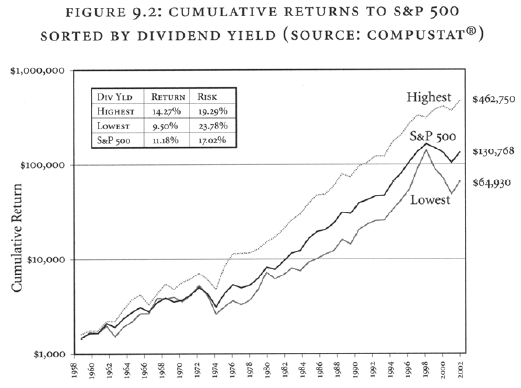"The deepest sin against the human mind is to believe things without evidence."
-T.H. Huxley
Why are high-yield portfolios dismissed as inferior to their growth counterparts?
Could it be that investors are taught that increasing dividend yields mean lower portfolio returns? Or that dividend payments mean that management believes the company is finished growing?
Both couldn't be further from the truth.
Look no further than the oft-mentioned "Dogs of the Dow" to disprove the mainstream's idea towards high-yield investing.
The Dogs of the Dow is a simplistic, yet highly effective investment strategy that buys and holds equal dollar amounts of the 10 highest yielding dividend stocks in the Dow Jones Industrial Average (NYSE: DIA). Investors buy into the high-yielding dividend stocks at the beginning of each year and then adjust accordingly at the end of the year to include the 10 highest yielding stocks in the Dow. Simple right?
More important than the strategy's simplicity, is the overall returns.
Over the last 25 years, the Dogs of the Dow have compounded at an annual rate of 18.0%, which outperforms the Dow and the majority of money managers by a healthy margin.
So, what does 18% compounded annually mean to investors?
Well, a $10,000 Dogs of the Dow portfolio would be increased to over $625,000 over 25 years while the average index fund would have grown to around $330,000 over the same time frame.
But if the Dogs of the Dow strategy wasn't enough to make you believe in high-yield portfolios, just towards famous Wharton finance scholar Jeremy Siegel's study on the subject.
The noted finance professor found that over the past 45 years, the highest yielding 20% of S&P 500 stocks "produced an annualized return of over 14.3% versus an annualized return of 11.2% for the S&P 500 index, which resulted in three times the wealth accumulation of the index."

As you can see the from the chart above the highest yielding stocks turned a $1,000 investment in 1957 into $462,750 by 2002, compared to $130,768 if the same money was invested in the S&P 500.
So, what about in declining markets? How do dividends-paying stocks perform?
According to a study in 2005 by financial analysts Fuller and Goldstein, "dividend-paying stocks outperform non-dividend paying stocks by 1% to 1.5% per month in declining markets than in advancing markets".
So, as you can from the evidence above investing in dividend stocks is one of the top investment strategies over the long-term.
Don't let the misconceptions and market myths deter you from getting into the action.
Dividend investing isn't a get-rich-quick strategy. It's a great way to build wealth over the long term to secure a steady cash flow for your retirement years.
Invest now and invest often with dividend-paying stocks.
If you're interested in checking out a low-cost way to get started as a dividend investor, take a look at the "Dividend Calendar" we've put together. It includes companies you can buy today that will pay ensure that you'll receive monthly dividend checks.
Good Investing,
Andy Crowder
Editor and Chief Options Strategist
Options Advantage and The Strike Price
 Facebook
Facebook
 Twitter
Twitter